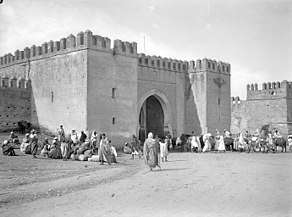Gates of Fez
The Gates of Fez are a fortification in Fez, Morocco. They were the seat of the Kingdom of Fez. It is a historic city in Morocco, with the old city broadly consists of two medina quarters and French-built Ville Nouvelle. The medina quarters can be divided into the older Fes el Bali which developed through 8th to 9th century under the Idrisid dynasty, and the newer Fes Jdid founded by the Marinid dynasty in the 13th century.[1] Fes el Bali contains several medieval palaces, mosques, mansions, tanneries, and madrasas, and it was divided into 18 another smaller quarters which contains its own schools, baths and other public facilities. The entire medina was surrounded by the fortress walls in order to protect these facilities, enclosed by the military detachments guarding the eight main entrance gates. Fes Jdid exists on the outside of these gates, and three new gates such as Bab al-Amer were established as perimeters between these two medinas.[2][3]
Gates of Fez
- Bab al-Amer: It was first constructed in 1276. It is the main western entrance to Fes Jdid and is located near the Jewish Quarter (Mellah).
- Bab al-Fetouh: One of the main gates of Fes el Bali, located on its southeastern side. It dates from the Almohad period.[4]
- Bab Bou Jeloud: The main western entrance to Fes el-Bali, and an iconic monument of the medina of Fez. It was built in 1913 at the beginning of French colonial rule, replacing an older gate and more modest gate of the same name.[5]
- Bab Chorfa: The gate to the Kasbah An-Nouar, a citadel at the western end of Fes el-Bali. Its current form dates from the Alaouite era.[6]
- Bab Dekakene[7]: Situated at Mawlai al-Hassan Street, it is close to Dar al-Makhzen, the royal palace.[8]
- Bab El-Seba
- Bab Fallali[9]
- Bab Guissa: Built in the 12th century.[10] Situated near Bab Guissa Mosque.
- Bab Hadid[11]
- Bab Jedid[12]
- Bab Jial[13]
- Bab Mahrouk: It was first constructed in the 13th century during the rule of Muhammad al-Nasir, in Almohad architectural style. It exists alongside the Bab Mahrouk cemetery and Kasbah An-Nouar.[14]
- Bab Segma[15]
- Bab Semmarine
Gallery
.jpg)
- Bab El-Seba
- Bab Semmarine
 Bab al-Fetouh
Bab al-Fetouh
References
- ↑ Fez and the Middle Atlas (Rough Guides Snapshot Morocco). Penguin.
- ↑ Meredith, Martin. (2014). Fortunes of Africa: A 5,000 Year History of Wealth, Greed and Endeavour. Simon and Schuster.
- ↑ Hakluyt Society, (1896). Works Issued by the Hakluyt Society, p.592.
- ↑ Bab al-Fetouh. Archnet Retrieved January 22, 2018.
- ↑ Bab Bu Jallud. Archnet Retrieved January 22, 2018.
- ↑ Le Tourneau, Roger (1949). Fès avant le protectorat : étude économique et sociale d'une ville de l'occident musulman. Casablanca: Société Marocaine de Librairie et d'Édition. pp. 74, 84, 107–108, 188, 265–266.
- ↑ Bab Dekakene. Archnet Retrieved January 22, 2018.
- ↑ فاس جديد تحتضن 17 بابا. Assabah. Retrieved January 24, 2018.
- ↑ Bab Fallali. Archnet Retrieved January 22, 2018.
- ↑ Bab Guissa. Archnet. Retrieved January 24, 2018.
- ↑ Bab Hadid. Archnet Retrieved January 22, 2018.
- ↑ Bab Jedid. Archnet Retrieved January 22, 2018.
- ↑ Bab Jial. Archnet Retrieved January 22, 2018.
- ↑ Bab Mahrouk. Archnet Retrieved January 22, 2018.
- ↑ Bab Segma. Archnet Retrieved January 22, 2018.
External links
| Wikimedia Commons has media related to Gates of Fes. |
